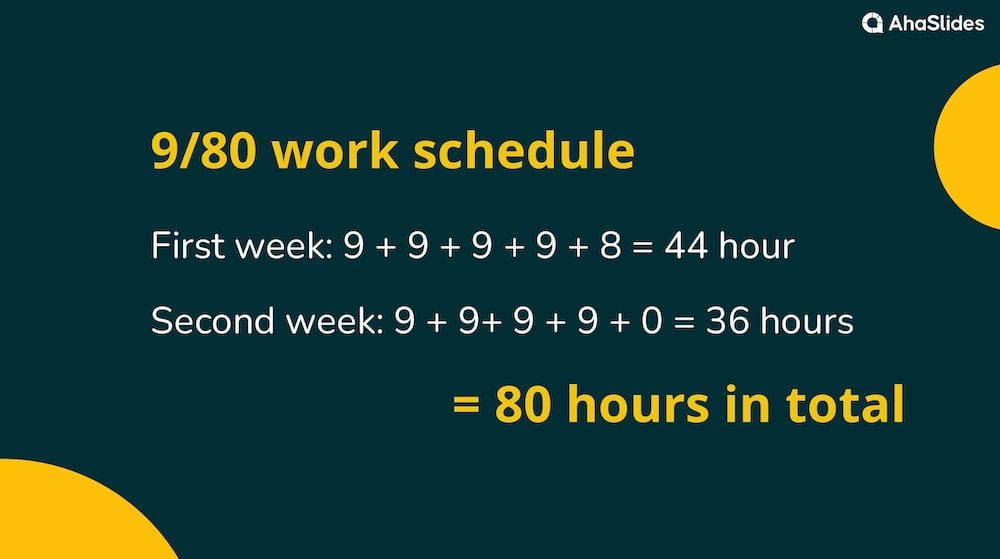Czy kiedykolwiek czułeś, że klasyczny harmonogram 9-5 jest po prostu zbyt nudny i ograniczający w dzisiejszych czasach? Cóż, nie jesteś sam – mnóstwo ludzi uważa, że czas na coś nowego.
Coraz więcej firm zdaje sobie z tego sprawę i zaczyna oferować alternatywy dla standardowej harówki od 9:5 do XNUMX:XNUMX.
Jedną z opcji, która zyskuje coraz większą popularność, jest system pracy 80/9.
Nie jesteś pewien, czy to będzie dobre rozwiązanie dla Ciebie lub Twojego zespołu? Nie martw się, wszystko Ci wyjaśnimy.
Wyjaśnimy dokładnie, jak Harmonogram pracy 9-80 działa, zalety i wady zarówno dla pracowników, jak i pracodawców oraz czy może to być dobre rozwiązanie dla Twojej firmy.
Spis treści
- Co to jest harmonogram pracy 9-80?
- Jaki jest przykład harmonogramu pracy 80-9?
- Jakie są zalety harmonogramu pracy 9–80?
- Potencjalne wady harmonogramu pracy 9–80
- Na wynos
- Najczęściej zadawane pytania
Wskazówki dotyczące lepszego zaangażowania

Szukasz więcej zabawy podczas spotkań?
Zbierz członków swojego zespołu w zabawnym quizie na AhaSlides. Zarejestruj się, aby wziąć udział w darmowym quizie z biblioteki szablonów AhaSlides!
🚀 Weź darmowy quiz☁️
Co to jest harmonogram pracy 9-80?
Harmonogram pracy 9/80 jest alternatywą dla tradycyjne 9-5, pięciodniowy tydzień pracy, w którym zamiast pracować 8 godzin dziennie, od poniedziałku do piątku, ty pracować 9 godzin dziennie w dwutygodniowym okresie pracy.
Daje to łącznie 80 godzin co dwa tygodnie (9 dni x 9 godzin = 81 godzin minus 1 godzina nadgodzin).
Masz co drugi piątek wolny jako twój dzień elastyczny. Tak więc w jednym tygodniu będziesz pracować od poniedziałku do czwartku, a w następnym od poniedziałku do piątku.
Daje to 3-dniowy weekend co drugi tydzień, więc skutecznie otrzymujesz dodatkowy czas wolny bez wykorzystywania dni urlopu.
Twój harmonogram jest zwykle ustawiony tak, że Twój elastyczny dzień przypada na ten sam dzień każdego okresu rozliczeniowego. To pozwala zachować spójność.
Pomiar czasu nadal jest zgodny ze standardem 40-godzinny tydzień pracy zasady wynagradzania za nadgodziny. Wszystko powyżej 8 godzin dziennie lub 80 godzin w okresie rozliczeniowym uruchamia OT.

Jaki jest przykład harmonogramu pracy 80/9?
Oto przykład harmonogramu pracy 9/80 z godzinną przerwą na lunch każdego dnia:
| Tydzień 1 | Tydzień 2 |
| Poniedziałek 8:00 – 6:00 wtorek 8:00 – 6:00 Środa 8:00 – 6:00 Czwartek 8:00 – 6:00 Piątek 8:00 - 5:00 | Poniedziałek 8:00 – 6:00 wtorek 8:00 – 6:00 Środa 8:00 – 6:00 Czwartek 8:00 – 6:00 Piątkowy dzień wolny |
Niektóre popularne branże korzystające z harmonogramu pracy 9–80 obejmują:
Biura rządowe – Agencje federalne, stanowe i lokalne często oferują pracownikom 9-80. Takie rzeczy jak DMV, usługi pocztowe i wydziały robót publicznych.
Zdrowie – Szpitale chcą mieć dostęp do opieki przez 7 dni w tygodniu, więc rotacyjne piątki wolne w tym pomagają. Pracownicy biurowi, tacy jak kliniki i laboratoria, również to przyjmują.
Użytkowe – Miejsca takie jak zakłady uzdatniania wody, firmy energetyczne itp. wymagają stałego monitoringu, aby harmonogram zapewniał lepszy zasięg.
Produkcja – W przypadku hal produkcyjnych pracujących 24 godziny na dobę, 7 dni w tygodniu system 9/80 pomaga zapewnić odpowiednią obsadę personelu na wszystkich zmianach, zapewniając jednocześnie elastyczność.
Telefoniczne centra obsługi – Zadania związane z obsługą klienta dobrze współgrają z harmonogramem, ponieważ czas oczekiwania jest krótki, a weekendy są przesunięte.
Egzekwowanie prawa – Posterunki policji, więzienia i sądy przyjęły tę zasadę już na wczesnym etapie, aby dostosować ją do godzin pracy.
Sprzedaż detaliczna – Sklepy otwarte w weekendy traktują to jako okazję do zatrzymania pracowników zatrudnionych na pełen etat.
Transport – Od linii lotniczych po firmy transportowe, a nawet dział pojazdów mechanicznych.
Technologia – Start-upy i firmy technologiczne mogą chcieć wdrożyć taki harmonogram pracy, aby zwiększyć elastyczność i przyciągnąć utalentowanych pracowników.
Jakie są zalety harmonogramu pracy 9–80?
Czy w Twojej firmie można wdrożyć harmonogram pracy 9-80? Rozważ te korzyści, aby sprawdzić, czy to dobre rozwiązanie:
Dla Pracowników

- Co drugi piątek wolny – Ten dwutygodniowy harmonogram daje pracownikom dodatkowe pół dnia wolnego co drugi tydzień, co w zasadzie zapewnia dodatkowy dzień wolny w każdym okresie rozliczeniowym. Umożliwia to 3-dniowe weekendy lub przerwę w środku tygodnia.
- Utrzymuje 40-godzinny tydzień pracy – Pracownicy nadal pracują 80 godzin w ciągu dwutygodniowego okresu, więc nie tracą żadnych płatnych godzin. Może to pomóc utrzymać zdrową równowagę między życiem zawodowym a prywatnym.
- Elastyczność – harmonogram oferuje większą elastyczność niż tradycyjny harmonogram poniedziałek-piątek. Pracownicy mogą umawiać spotkania lub załatwiać sprawy osobiste w swoje „wolne” piątki bez korzystania z PTO.
- Niższe koszty dojazdów – Dzięki temu, że co drugi piątek jest wolny, pracownicy oszczędzają na benzynie i transporcie przez jeden tydzień na dwa. Może to obniżyć ich miesięczne wydatki.
- Zwiększona produktywność – niektóre badania pokazują elastyczny grafik prowadzi do większej satysfakcji z pracy i mniej wypalenia zawodowego, co może zwiększyć zaangażowanie i produktywność pracowników.
- Więcej czasu na pracę na pół etatu – Choć nie polecamy tego, ponieważ może mieć negatywny wpływ na zdrowie psychiczne i fizyczne, dodatkowy dzień wolny daje niektórym możliwość podjęcia dodatkowej pracy lub podjęcia pracy na pół etatu w celu zarobienia dodatkowego dochodu.
Dla Pracodawców

- Zwiększona produktywność – Badania pokazują, że harmonogram może zmniejszyć stres i wypalenie, co prowadzi do wyższej jakości pracy. Pracownicy mogą być bardziej skupieni i zaangażowani.
- Niższe koszty ogólne – biura mogą być zamknięte co drugi piątek, co pozwala zaoszczędzić na rachunkach za media, konserwacji i innych wydatkach ogólnych za tę połowę dnia w tygodniu.
- Przyciągaj i zatrzymuj talenty – daje to firmie przewagę w rekrutacji i utrzymaniu najlepszych pracowników, którzy cenią sobie elastyczność w miejscu pracy.
- Lepsza obsługa klienta – Utrzymanie dyżurów w dodatkowych godzinach pozwala na obsługę klientów lub obsługę spotkań/połączeń przez cały tydzień roboczy.
- Elastyczność harmonogramu – menedżerowie mają możliwość elastycznego przydzielania odpowiedniej liczby pracowników do projektów lub zadań w ciągu pełnego czasu pracy każdego dnia.
- Mniej absencji – Pracownicy prawdopodobnie będą rzadziej korzystać ze zwolnień lekarskich lub nieplanowanego czasu wolnego, ponieważ będą mieli więcej czasu w innych miejscach.
- Wzrost morale i współpracy – Większa satysfakcja z pracy wynikająca z harmonogramu przekłada się na lepszą kulturę firmy i relacje między działami.
Potencjalne wady harmonogramu pracy 9–80

Zanim przejdziesz do zmiany polityki, musisz rozważyć negatywne strony tego odrębnego harmonogramu pracy, takie jak:
- Złożoność administracyjna – Wymaga większej koordynacji i planowania, aby zapewnić odpowiednią obsługę wszystkich działów każdego dnia.
- Potencjalny brak zasięgu – W przypadku niektórych stanowisk może nie być wystarczającej liczby pracowników w dłuższe dni robocze lub w „wolne” piątki.
- Koszty nadgodzin – Pracownicy pracujący ponad 8 godzin w zaplanowanym dłuższym dniu powodują konieczność zapłaty wynagrodzenia za nadgodziny.
- Nieelastyczność – harmonogram jest sztywny i nie pozwala na łatwą zmianę dni/godzin w miarę zmian potrzeb. Może nie pasować do wszystkich ról.
- Śledzenie godzin – Menedżerom i pracownikom ds. płac trudniej jest dokładnie śledzić godziny w niestandardowym tygodniu pracy. Ustrukturyzowane wdrożenie jest ważne z harmonogramem rejestracji i okresem przejściowym na koordynację/komunikację.
- Nieporozumienia – Ryzyko nieporozumień wzrasta, jeśli dostępność personelu zmienia się co dwa tygodnie.
- Wpływ na współpracę – Praca w różnych zespołach według różnych harmonogramów może negatywnie wpłynąć na współpracę i pracę grupową.
- Nierówności – Nie wszystkie stanowiska lub funkcje mogą być odpowiednie dla harmonogramu, co powoduje nierówności między rolami. Niektóre role, takie jak obsługa klienta, opieka zdrowotna lub praca zmianowa, mogą nie pozwalać na elastyczność harmonogramu.
- Nierównomierne obciążenie pracą – praca może być nierównomiernie rozłożona w dwutygodniowym harmonogramie.
- Problemy z integracją – dla pracowników 9/80 skuteczna koordynacja z partnerami w ramach standardowego harmonogramu MF może być wyzwaniem.
Na wynos
Harmonogram pracy 9-80 zapewnia więcej czasu wolnego bez zmniejszania wynagrodzenia lub zwiększania godzin, przy jednoczesnym zachowaniu wysokiego poziomu elastyczności.
Zapewnia wiele korzyści przy odpowiednim planowaniu, ale może nie pasować do wszystkich branż lub preferencji kulturowych/komunikacyjnych firmy.
Szkolenia dotyczące szczegółów harmonogramu, takich jak mierzenie czasu, zasady obecności i koordynacja z kolegami pracującymi według standardowego harmonogramu, mają kluczowe znaczenie dla utrzymania płynnego przepływu pracy.
Trenuj efektywnie, kiedykolwiek i gdziekolwiek jesteśNowe zasady wymagają czasu na przyjęcie. Przekazuj swoje informacje w jasny sposób za pomocą atrakcyjnych ankiet i pytań i odpowiedzi.
Najczęściej zadawane pytania
Ile godzin tygodniowo obejmuje harmonogram 9/80?
W harmonogramie pracy 9/80 pracownicy pracują 9 godzin dziennie przez 9 dni w dwutygodniowym okresie rozliczeniowym.
Co to jest harmonogram pracy 3 12?
Harmonogram pracy 3/12 odnosi się do rotacji, w której pracownicy pracują na 12-godzinnych zmianach przez 3 dni w tygodniu.
Co to jest harmonogram 9 80 w Teksasie?
Harmonogram 9/80 działa tak samo w Teksasie, jak w innych stanach. Pracodawcy w Teksasie mogą wdrożyć harmonogram 9/80 jako elastyczną opcję pracy dla pracowników, o ile przestrzegane są zasady dotyczące nadgodzin.
Czy harmonogram 9 80 jest legalny w Kalifornii?
Pracodawcy z Kalifornii mogą korzystać z alternatywnych harmonogramów tygodni pracy, takich jak 9/80, o ile przestrzegają przepisów dotyczących wynagrodzeń i godzin pracy. Harmonogram musi zostać przyjęty większością co najmniej 2/3 głosów zainteresowanych pracowników w głosowaniu tajnym. Uzasadnia to zmianę harmonogramu.








